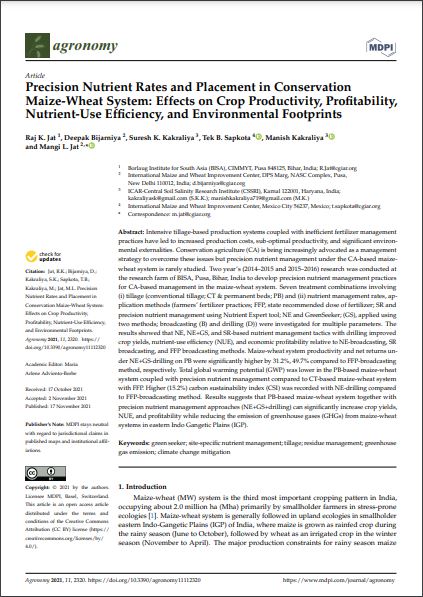Intensive tillage-based production systems coupled with inefficient fertilizer management practices have led to increased production costs, sub-optimal productivity, and significant environmental externalities. Conservation agriculture (CA) is being increasingly advocated as a management strategy to overcome these issues but precision nutrient management under the CA-based maize-wheat system is rarely studied. Two year’s (2014–2015 and 2015–2016) research was conducted at the research farm of BISA, Pusa, Bihar, India to develop precision nutrient management practices for CA-based management in the maize-wheat system. Seven treatment combinations involving (i) tillage (conventional tillage; CT & permanent beds; PB) and (ii) nutrient management rates, application methods (farmers’ fertilizer practices; FFP, state recommended dose of fertilizer; SR and precision nutrient management using Nutrient Expert tool; NE and GreenSeeker; (GS), applied using two methods; broadcasting (B) and drilling (D)) were investigated for multiple parameters. The results showed that NE, NE+GS, and SR-based nutrient management tactics with drilling improved crop yields, nutrient-use efficiency (NUE), and economic profitability relative to NE-broadcasting, SR broadcasting, and FFP broadcasting methods. Maize-wheat system productivity and net returns under NE+GS-drilling on PB were significantly higher by 31.2%, 49.7% compared to FFP-broadcasting method, respectively. Total global warming potential (GWP) was lower in the PB-based maize-wheat system coupled with precision nutrient management compared to CT-based maize-wheat system with FFP. Higher (15.2%) carbon sustainability index (CSI) was recorded with NE-drilling compared to FFP-broadcasting method. Results suggests that PB-based maize-wheat system together with precision nutrient management approaches (NE+GS+drilling) can significantly increase crop yields, NUE, and profitability while reducing the emission of greenhouse gases (GHGs) from maize-wheat systems in eastern Indo Gangetic Plains (IGP).

